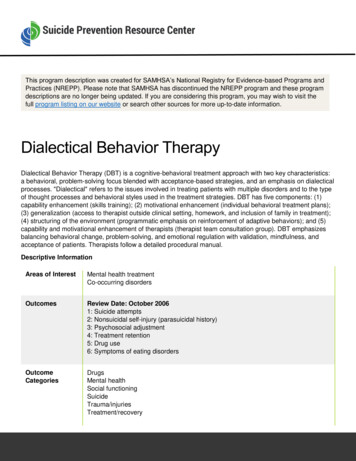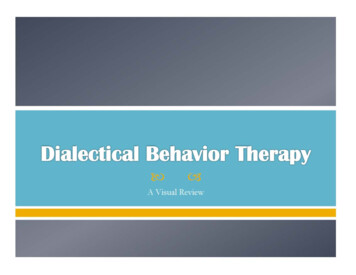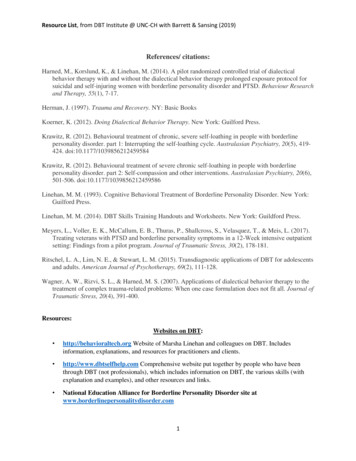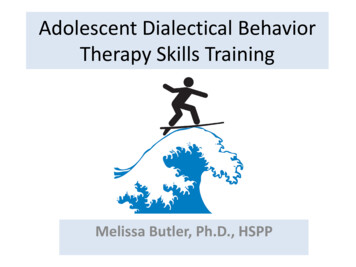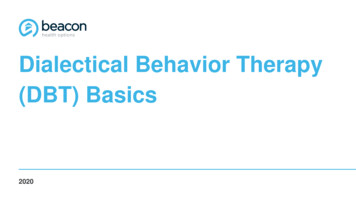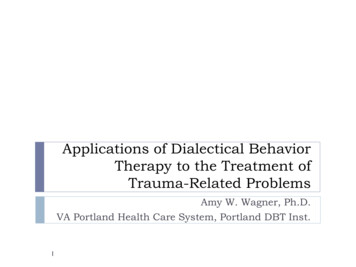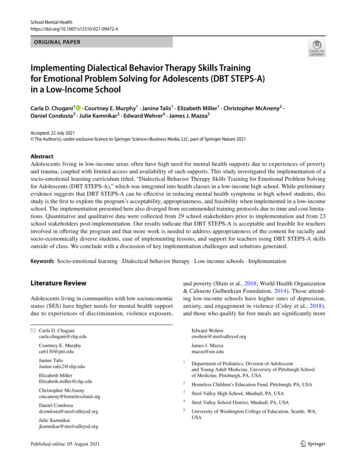
Transcription
School Mental IGINAL PAPERImplementing Dialectical Behavior Therapy Skills Trainingfor Emotional Problem Solving for Adolescents (DBT STEPS‑A)in a Low‑Income SchoolCarla D. Chugani1 · Courtney E. Murphy1 · Janine Talis1 · Elizabeth Miller1 · Christopher McAneny2 ·Daniel Condosta3 · Julie Kamnikar3 · Edward Wehrer4 · James J. Mazza5Accepted: 22 July 2021 The Author(s), under exclusive licence to Springer Science Business Media, LLC, part of Springer Nature 2021AbstractAdolescents living in low-income areas often have high need for mental health supports due to experiences of povertyand trauma, coupled with limited access and availability of such supports. This study investigated the implementation of asocio-emotional learning curriculum titled, “Dialectical Behavior Therapy Skills Training for Emotional Problem Solvingfor Adolescents (DBT STEPS-A),” which was integrated into health classes in a low-income high school. While preliminaryevidence suggests that DBT STEPS-A can be effective in reducing mental health symptoms in high school students, thisstudy is the first to explore the program’s acceptability, appropriateness, and feasibility when implemented in a low-incomeschool. The implementation presented here also diverged from recommended training protocols due to time and cost limitations. Quantitative and qualitative data were collected from 29 school stakeholders prior to implementation and from 23school stakeholders post-implementation. Our results indicate that DBT STEPS-A is acceptable and feasible for teachersinvolved in offering the program and that more work is needed to address appropriateness of the content for racially andsocio-economically diverse students, ease of implementing lessons, and support for teachers using DBT STEPS-A skillsoutside of class. We conclude with a discussion of key implementation challenges and solutions generated.Keywords Socio-emotional learning · Dialectical behavior therapy · Low-income schools · ImplementationLiterature ReviewAdolescents living in communities with low socioeconomicstatus (SES) have higher needs for mental health supportdue to experiences of discrimination, violence exposure,and poverty (Shim et al., 2018; World Health Organization& Calouste Gulbenkian Foundation, 2014). Those attending low-income schools have higher rates of depression,anxiety, and engagement in violence (Coley et al., 2018),and those who qualify for free meals are significantly moreEdward Wehrerewehrer@steelvalleysd.org* Carla D. Chuganicarla.chugani@chp.eduJames J. Mazzamazza@uw.eduCourtney E. Murphyceb130@pitt.eduJanine TalisJanine.talis2@chp.eduElizabeth MillerElizabeth.miller@chp.edu1Department of Pediatrics, Division of Adolescentand Young Adult Medicine, University of Pittsburgh Schoolof Medicine, Pittsburgh, PA, USA2Christopher McAnenycmcaneny@homelessfund.orgHomeless Children’s Education Fund, Pittsburgh, PA, USA3Steel Valley High School, Munhall, PA, USADaniel Condostadcondosta@steelvalleysd.org4Steel Valley School District, Munhall, PA, USA5University of Washington College of Education, Seattle, WA,USAJulie 789)
School Mental Healthlikely to have mental health, social, and behavioral challenges (Deighton et al., 2019). Coupled with increasedmental health needs, adolescents in low-SES communitieshave decreased access to mental health care arising from anumber of factors, including stigma, long wait times, lack ofproviders specializing in mental health care for teens (Silberholz et al., 2017), limited finances/insurance coverage,and transportation.School-based socio-emotional learning (SEL) programsare a highly promising strategy for universal access to mental health supports, yet they typically achieve small effectsor mixed effects for mental health outcomes (National Academies of Sciences, 2019). Three recent meta-analyses havebeen conducted which examine the effects of SEL programsfor a variety of standard SEL outcomes including skill building, academic achievement, behavior problems, and mentalhealth (Durlak et al., 2011; Sklad et al., 2012; Taylor et al.,2017). These studies have consistently found that SEL programs achieve small effect sizes for mental health outcomes(d 0.16–0.24). These small effects and mixed results mayresult from challenges in implementing such programs in theschool system and issues with program fidelity. While quality implementation supports program effectiveness (Durlaket al., 2011), the implementation research-related to SEL islimited and focused on sub-constructs of overall implementation success such as fidelity or dosage (Low et al., 2016).More broadly, barriers to implementation of school-basedmental health programs include competing responsibilities,logistical barriers, and lack of support from school administrators and teachers, whereas facilitators include having asocial network among implementers, more organizationalstructure, and administrative support (Langley et al., 2010).It is also noteworthy to mention that SEL programs mayfocus on many different types of skill building includingareas such as goal setting, problem solving, or in the caseof suicide prevention, help-seeking, and gatekeeper trainingdesigned to help individuals learn to recognize and respondto a person who is displaying warning signs of suicidality. SEL programs that aim to improve mental health mayachieve small effects if the skills taught do not directly assistyouth in learning how to cope, regulate emotions, or modifyfactors causing emotional distress. In many cases, these programs may actually be targeting mental well-being ratherthan emotional distress, which most rigorously evaluatedSEL programs have been shown to have either low or noefficacy for reducing (Collaborative for Academic Social andEmotional Learning (CASEL), 2015). Even among SEL programs designed to prevent suicide, there is a lack of focus onteaching specific skills for reducing emotional arousal anddistress. For example, the peer-delivered Sources of Strengthprogram (LoMurray, 2005) is designed to promote identification and engagement with “trusted adults,” encourages students who identify a friend as suicidal to seek out help, and13encourages identification of coping resources (Wyman et al.,2010). Sources of Strength has been shown to be effectivefor increasing acceptability of help-seeking and perceivedadult support for suicidality (Wyman et al., 2010). The Signsof Suicide program (MindWise Innovations, 2021), whichhas been shown to be effective for reducing suicide attemptsin high school students, is designed to educate students aboutdepression and suicide ideation, encourage intervention withsuicidal peers, and promote help-seeking among youth experiencing suicide ideation (Schilling et al., 2016). AlthoughSEL programs can achieve a range of important outcomesrelated to mental health, a gap persists in programs providing direct instruction on specific coping skills to directlytarget emotional distress or behavioral dysregulation.Dialectical Behavior Therapy Skills Training for Emotional Problem Solving for Adolescents (DBT STEPS-A) isan SEL curriculum which allows general education teachers to teach mindfulness, emotion regulation, distress tolerance, and interpersonal effectiveness skills from dialecticalbehavior therapy (DBT) through 30 manualized lessonsdesigned for 50 min periods (Mazza et al., 2016). DBTSTEPS-A is based on the skills training component of DBT(Linehan, 1993), an evidence-based cognitive behavioraltherapy that has repeatedly been shown to be effective forimproving mental health outcomes in adolescents and adults(Chen et al., 2008; Chugani et al., 2013; Linehan et al., ,1999, 2006, 2015; Miller et al., 2006; Perepletchikova et al.,2011). Unlike therapies that target a specific symptom (e.g.,depression), DBT has demonstrated transdiagnostic effectiveness (Neacsiu et al., 2014; Ritschel et al., 2015) for awide range of mental health challenges including depressionand anxiety (Panepinto et al., 2015; Ritschel et al., 2012),suicidality (Linehan et al., 2006, 2015), addiction (Dimeff& Linehan, 2008; Linehan et al., 1999; Wilks et al., 2017),and eating disorders (Chen et al., 2008). Unlike many rigorously evaluated SEL programs, which show low or noefficacy for reducing emotional distress (Collaborative forAcademic Social and Emotional Learning (CASEL), 2015),DBT STEPS-A directly targets mental health by combiningmindfulness with skills for emotion regulation, distress tolerance, and interpersonal effectiveness and as such, was anideal candidate for our pilot project, as our long term goalwas to improve student mental health through reductionsin distress and mental health symptoms (e.g., depression).The program shows preliminary effectiveness for reducing emotional symptoms and internalizing problems (e.g.,depression, anxiety) in high school students (Flynn et al.,2018a, 2018b) and has also shown effectiveness for socialresilience and difficulties with emotion regulation in raciallydiverse, rural ninth-graders (Martinez Jr. et al., 2021). However, the present study is the only investigation to date on theacceptability and feasibility of DBT STEPS-A and the onlyto focus on a low-income school. The focus on establishing
School Mental Healthacceptability and feasibility specifically with low-incomeschools is particularly important, as SEL programs like DBTSTEPS-A will not likely reach these schools and studentsunless they are optimized to fit with available resources andto be culturally responsive to the needs and experiences ofstudents. While larger, more rigorous trials of DBT STEPSA are needed to investigate efficacy, a first step in this area ofinquiry is to establish the acceptability, appropriateness, andfeasibility of the model to inform strategic adjustments priorto large-scale studies. In this study, we aimed to address thisgap by: (1) evaluating an implementation of DBT STEPS-Aintegrated into required high school health classes, and (2)partnering with a low-income high school situated within alow-SES community to evaluate the potential for dissemination of the program into such communities.Background and Community ContextThe superintendent of a Southwestern Pennsylvania public school district assembled a coalition of community andschool stakeholders to address a recently received designation for Additional Targeted Support and Improvement(A-TSI) by the Pennsylvania Department of Education dueto racial disparities in academic achievement and schoolattendance (Pennsylvania Department of Education, 2019).Investigators from the University of University of Pittsburghwith expertise in school-based health initiatives were invitedto attend. At this time, the superintendent expressed a desireto include an initiative to support the mental health of students in the district. Supporting student mental health withinthis district has been an ongoing challenge on several fronts.First, the district is located in a low-SES community withhigh rates of community violence. Within the high school,67.3% of students are economically disadvantaged, 21.5%receive special education, and the racial demographics areas follows: 56.3% White, 34.3% Black, 1.8% Hispanic, 1.1%Asian, and 6.4% two or more races. Within the school district overall, 27% of children live below the poverty line.Second, few mental health providers are available in thelocal community. Third, even when students are referred tothe school’s program for addressing mental health problems,parents often do not provide their consent for students toparticipate.Planning and DevelopmentGiven the challenges in addressing student mental healthoutside of the school context, we devised a plan for bringingmore mental health support into the school by implementingthe DBT STEPS-A curriculum as an upstream approach tobe integrated within high school health classes required forgraduation. The standard training protocol for implementingDBT STEPS-A is attendance at a three-day training event ledby the curriculum developers. Typically, school districts orcollaborating community agencies contract with the programdevelopers to offer the training, allowing teachers and behavioral health specialists from across the district to attend. It isalso strongly recommended that a half-day training specifically geared toward school administrators be offered during initial training. Finally, it is recommended that schoolsimplementing the program receive ongoing expert consultation during at least the first year of implementation at a rateof one hour per month.When this ideal training scenario was presented to thedistrict superintendent, it became clear that this would notbe feasible for several reasons. First, the district would not beable to afford the cost of the training as it is a small district(two elementary, one middle, and one high school). Second,the time needed to send teachers to three consecutive daysof training was not available. Third, the teacher’s collective bargaining agreement mandates that any work they dooutside of regular school hours (e.g., summer months) willresult in additional hourly compensation. Fourth and perhaps most challenging to address, asking teachers to learna completely new curriculum from a content area outsideof their typical health class expertise was potentially overwhelming and could diminish teacher willingness and enthusiasm for the program. Instead of attempting the traditionaltraining and implementation strategy for DBT STEPS-A,the superintendent recommended we explore the option ofusing a co-teaching model in which a fully trained individualwould co-teach with high school health teachers, allowingthem to learn the content and curriculum delivery over time.Given the clear barriers with the traditional training modeland high need for mental health support in the school district, we agreed to develop a co-teaching model for programimplementation.The next challenge was to locate an appropriate coteacher to partner in the project. In our community, we arefortunate to have a community-based organization calledthe Homeless Children’s Education Fund (HCEF), whosemission is to support the educational needs of childrenexperiencing homelessness in Allegheny County. HCEFhas found that it can often be most effective to reach theseyouth via schools, as they can be difficult to access outsideof school hours due to parentification (having to take on aparent role for siblings), the need to work, housing instability, or difficulties accessing transportation. Three years ago,HCEF’s teen program manager began offering college andcareer readiness programming in local public schools. Giventhat children experiencing homelessness have high rates ofmental health symptoms and HCEF providers were alreadyembedded within public school classrooms, it was a naturalfit to invite HCEF’s teen program manager to partner with us13
School Mental Healthas the trained co-teacher. It is important to note that HCEF’steen program manager does not have any formal training orexperience in the provision of mental health services, noris such training required to teach DBT STEPS-A lessons.Though in this specific case, we leveraged a relationshipwith a community-based organization to partner with theschool, we assert that the co-teaching model could be implemented with anyone meeting the following criteria:1. Highly enthusiastic about bringing DBT STEPS-A to thelocal school district2. Has access to classrooms and resources to do so (i.e.,has time and ability to travel to school classrooms, ableto pass all required background checks)3. Willing to participate in a three-day DBT STEPS-Atraining4. Committed to working as a co-teacher until health teachers are able to teach the lessons independently (we anticipate this process will take approximately 2 years)MethodsTraining Protocol and ParticipantsOur co-teaching model of implementation is based on thepremise that when time and resources are scarce (such asin the case of many low-income schools), available supportand resources should be directed most heavily onto key program implementers. We obtained an internal grant (Clinical and Translational Science Award) to support the project. The first step in this process was to send a communitypartner who agreed to serve as the co-teacher to a standardthree-day DBT STEPS-A training event led by the programdevelopers. Following this, one of the program developersprovided a one-day presentation on DBT STEPS-A designedto enhance interest among key school stakeholders including 21 general education teachers, two special educationteachers, two school counselors/psychologists, and threeadministrators. The one-day presentation was held duringthe summer months, and all teachers in attendance werecompensated at their union-negotiated hourly rate hour forsix training hours plus one hour for lunch. Lunch and a copyof the DBT STEPS-A manual were provided to all attendees.Program LaunchIn the high school, health class is a one-semester course,which meets five days per week, 42 minutes per class period.Thus, we decided (with input from one of the program developers) that DBT STEPS-A lessons would occur on Mondays13and Thursdays. The curriculum delivery was structured thisway for two primary reasons: (1) giving a few days betweeneach lesson allows students some time to apply skills outsideof the classroom in their lives before learning the next skill,and (2) it allows for some integration of skills training withother health content (e.g., discussion of how the skills applyto other health topics such as setting limits in an intimaterelationship, having a discussion about consent, or sayingno when offered drugs or alcohol). The high school healthteachers (n 2) considered their current health curriculumand found that they could dedicate 33 class periods to DBTSTEPS-A while still adequately covering the remainingneeded content to adhere to educational standards for highschool health class. Though this would allow for delivery ofthe full 30-lesson curriculum, challenges related to lengthof class periods emerged early in the semester and it becamenecessary to switch to a 19-lesson version of the curriculumthat would allow for DBT STEPS-A lessons to be deliveredonly once per week, with a few exceptions where lessonsoccurred twice per week. Time issues included in-class challenges such as needing to take more time than planned toexplain certain concepts and the need to review homeworkassignments in class due to low completion rates, as wellas logistical challenges that interfered with delivery of theprogram as originally planned (e.g., senior skip days or otherschool events that cut into health class periods). The teamreceived expert consultation from one of the DBT STEPS-Aprogram developers to address these challenges, includingguidance on which parts of each lesson to shorten as wellas recommendations on which lessons to completely omit.The 19-lesson curriculum was designed to cover key skillsfrom all four core skills training modules and is consistentwith other DBT skills training protocols adapted due to timeconstraints (Chugani et al., 2013). Figure 1 provides a flowchart of the overall implementation process (establishingpartnerships, training, and program implementation).Role of Health Teachers and Co‑TeacherGiven that the health teachers had not received the standard3-day training to deliver DBT STEPS-A, the co-teacher’srole was to lead classes on days that program lessons werebeing delivered. Meanwhile, the health teachers added anyadditional information as needed, supported students in theirwork during these lessons, and related to content to otherhealth topics taught on days when the co-teacher wasn’t present (note that the co-teacher only joined health classes toteach DBT STEPS-A lessons twice per week). Since healthteachers knew their students better than the co-teacher, they
School Mental HealthFig. 1 Flowchart of partnerships, training, and implementation. PI Principal investigator13
School Mental Healthalso found that it was easier for them to tell when a studentneeded something to be re-worded or explained differentlyto better grasp the content.MeasuresPre‑Implementation MeasuresTo assess how well the one-day presentation was received byhigh school teachers and administrators, an internally developed training evaluation was administered that included fivequantitative items (e.g., “How valuable did you find today’straining?”) and four qualitative items (e.g., “What wouldhave made this training more valuable/useful for you?”). Thefive quantitative items were investigator-developed itemstypically used in educational training events, and all wererated on a five-point Likert scale ranging from “not at all”(1) to “extremely” (5).Participants in the one-day presentation also completedthe Acceptability of Intervention Measure (AIM), Intervention Appropriateness Measure (IAM), and Feasibilityof Intervention Measure (FIM), which are brief, validatedscales of the acceptability, appropriateness, and feasibilityof interventions (Weiner et al., 2017). Each scale has fouritems, and all three scales have demonstrated good discriminant and structural validity, test–retest reliability, and goodinternal consistency (α range 0.85–0.91). Items are ratedon a five-point Likert scale ranging from “completely disagree” (1) to “completely agree” (5).Post‑Implementation MeasuresTo examine fidelity and ease of use on a lesson-by-lessonbasis, a brief, electronic fidelity form was created which theco-teacher completed after each lesson (one rating per classperiod). The fidelity form captures the rater, lesson number,class period number, whether the lesson content was fullydelivered (if not, what percentage was delivered on a sliding scale of 0 to 100%), how easy it was to teach the lesson(rated on a five-point Likert Scale from “extremely difficult”(1) to “extremely easy” (5)), how well the students seemedto like the lesson (rated on a five-point Likert Scale from“dislike a great deal” (1) to “like a great deal” (5)), and anyTable 1 Participant ratings ontraining evaluation items13other notes about the class including successes, challenges,or other interesting things that happened. In vivo or videorecorded fidelity ratings were outside of the scope of thecurrent project.Finally, the 29 teachers and administrators (including thehealth teachers and our trained co-teacher) who participatedin the one-day presentation were invited to complete theAIM, IAM, and FIM at the end of the first semester during which the DBT STEPS-A was offered. In addition tothese measures, four qualitative items gathered feedbackon what else can be done to support program implementation, what participants would suggest if the implementationwas done again, additional feedback about any part of theDBT STEPS-A curriculum or training, and feedback for theresearch team about how to improve the partnership withthe school or district.AnalysesQuantitative items were analyzed descriptively (mean, standard deviation, range). Qualitative data were transcribed electronically and uploaded to Dedoose, a secure online platformfor qualitative data analysis (Sociocultural Research Consultants LLC, 2018). We set our benchmark for adequateacceptability, appropriateness, and feasibility as a mean rating of 4 (on a Likert scale of 1–5). Qualitative data werecoded by a research assistant under the supervision of thefirst author using a descriptive qualitative coding methodaiming to capture common patterns or themes in responsesamong participants (Sandelowski, 2000). The Universityof Pittsburgh Human Subjects Research Protections Office(HRPO) approved this study as an exempt protocol for evaluation of educational curricula.ResultsPre‑Implementation FindingsOverall, participants in the one-day presentation found theevent to be valuable and agreed that DBT STEPS-A wasimportant for high school students. Table 1 presents participants ratings on our internally developed training evaluationItem (n 29)MSDRange1. How valuable did you find today’s training?2. How important do you think it is for high school students to learn STEPS-A skills?3. How important you do think it is to include skills for emotional well-being andproblem solving in high school health curricula?4. How likely are you to use information you learned today in your teaching?5. How likely are you to use information you learned today in your personal life?3.93 0.75 2–54.62 0.49 4–54.59 0.69 2–53.93 0.70 2–53.90 0.77 2–5
School Mental HealthTable 2 Descriptive Statistics by Item for the Feasibility of Intervention Measure (FIM)Item (n 29)MSDRange1. DBT STEPS-A seems implementable2. DBT STEPS-A seems possible3. DBT STEPS-A seems doable4. DBT STEPS-A seems easy to 2–5items (n 29). Participant ratings also indicate that participants found DBT STEPS-A to be highly acceptable(M 4.47, SD 0.57, α 0.96) and appropriate (M 4.55,SD 0.53, α 0.94) for their school and students. In comparison, the scores for feasibility of the program were lower,though the overall mean score remained supportive (M 4.1,SD 0.57, α 0.88). Given this, each individual feasibilityitem was examined and results revealed that “ease of use”as a particular area was perceived as a relative weakness(see Table 2). It is important to note that these ratings wereprovided prior to program implementation, at the end of theone-day presentation.Qualitative Feedback on the One‑day PresentationParticipants almost unanimously felt the topics covered during the one-day DBT STEPS-A presentation were important,needed, and valuable. Overall, well-being, coping strategies,and mental health were highlighted as areas where strategic improvements were wanted and necessary. Participantsgenerally enjoyed the introduction to the DBT STEPS-Acurriculum, though some also expressed interest in beingable to see what the program was like once implemented.However, about one quarter of participants said they simplyfelt the presentation was too long or that there was too muchinformation presented at once for them to feel comfortableputting it to use. This left some participants feeling overwhelmed after the presentation concluded.Nearly all participants requested more information onhow to implement the program and apply DBT STEPS-Atechniques in real-life situations, with a few voicing logistical concerns. Among the suggestions related to what information would be desired should another training event occurwere: (1) more time for training, (2) more engagement withtrainees, and (3) more details on how to apply the programin their specific setting. Those who made these suggestionswere interested in reviewing specific materials (e.g., lesson plans) and obtaining a more in-depth understandingof the skills and strategies than what was introduced. Mostparticipants also suggested a more “hands on” approach,including a troubleshooting portion with time for questionsand answers. Participants also requested the addition of caseexamples or role-play scenarios to enrich the learning experience and to better illustrate implementation.Post‑Implementation FindingsAcceptability, appropriateness, and feasibility were reassessed at the end of the first semester of implementationwith the same 29 participants who attended the trainingevent being invited to complete the post-semester evaluation. All original training participants were included in thisevaluation regardless of their role in implementing the program with the focus on examining how the program wasperceived by a variety of school stakeholders. Overall, 23participants responded to the post-semester survey for a follow-up response rate of 79%. Respondents included threehealth teachers (including the trained co-teacher), four highschool/district administrators, 15 general education teachersnot directly involved in teaching DBT STEPS-A lessons aspart of health class, and one respondent who did not indicatetheir job role. Table 3 presents post-implementation ratingsof program acceptability, appropriateness, and feasibility forthe overall group of respondents, health teachers/co-teacherTable 3 Post-Implementation Ratings of Acceptability, Appropriateness, and Feasibility Overall, Among Those who Delivered DBTSTEPS-A Lessons, and Among Teachers, Staff, and AdministratorsConstructMSDRangeAcceptability (n 23)Health Teachers/Co-Teacher (n 3)Teachers/Staff/Administrators (n 19)Appropriateness (n 23)Health Teachers/Co-Teacher (n 3)Teachers/Staff/Administrators (n 19)Feasibility (n 21)Health Teachers/Co-Teacher (n 3)Teachers/Staff/Administrators (n �5Table 4 Post-Implementation Feasibility Ratings by Item AmongThose Who Delivered DBT STEPS-A Lessons (Health Teachers andCo-Teacher; n 3)ItemMSDRange1. DBT STEPS-A seems implementable2. DBT STEPS-A seems possible3. DBT STEPS-A seems doable4. DBT STEPS-A seems easy to 3
School Mental Healthalone (i.e., those who actually delivered the program), andteachers, school staff, and administrators who were trainedduring the summer but do not have direct responsibility forprogram delivery. The overall mean scores were 3.87 forprogram acceptability (4.33 among those who delivered theprogram), 3.95 for program appropriateness (3.75 amongthose who delivered the program), and 3.74 for feasibility(4.25 among those who delivered the program). Table 4presents the mean ratings for program feasibility by itemamong health teachers and the co-teacher (n 3; i.e., thosewho directly delivered the program).Qualitative Program FeedbackOf the 23 follow-up survey participants, 12 provided qualitative feedback about the program through fo
tional Problem Solving for Adolescents (DBT STEPS-A) is an SEL curriculum which allows general education teach-ers to teach mindfulness, emotion regulation, distress toler - ance, and interpersonal eectiveness skills from dialectical behavior therapy (DBT) through 30 manualized lessons designed for
